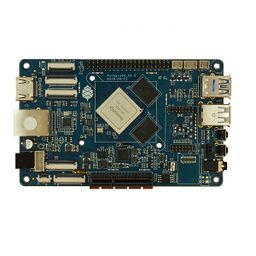NixOS on ARM/PINE64 ROCKPro64: Difference between revisions
imported>Kreyren Added more info on the connection using serial console |
fix links |
||
| (5 intermediate revisions by 4 users not shown) | |||
| Line 29: | Line 29: | ||
U-Boot for this board is packaged in nixpkgs, and Hydra builds can be found here: https://hydra.nixos.org/job/nixpkgs/trunk/ubootRockPro64.aarch64-linux | U-Boot for this board is packaged in nixpkgs, and Hydra builds can be found here: https://hydra.nixos.org/job/nixpkgs/trunk/ubootRockPro64.aarch64-linux | ||
It can also be [[NixOS on ARM#Compiling through binfmt QEMU | cross compiled]] with | |||
<syntaxhighlight lang="bash"> | |||
nix-build '<nixpkgs>' --argstr system aarch64-linux -A ubootRockPro64 --out-link ubootRockPro64 | |||
</syntaxhighlight> | |||
== Board-specific installation notes == | == Board-specific installation notes == | ||
| Line 51: | Line 56: | ||
== Serial console== | == Serial console== | ||
{{note|Do not connect RxD (pin 10) until the U-Boot SPL is running (see [RK3399 boot sequence|https://wiki.pine64.org/wiki/RK3399_boot_sequence]) or the SPL will not start}} | |||
The ROCKPro64 uses a GPIO pinout compatible with the Raspberry Pi 2 and newer. This means that the following pins can be used to connect a serial adapter: | The ROCKPro64 uses a GPIO pinout compatible with the Raspberry Pi 2 and newer. This means that the following pins can be used to connect a serial adapter: | ||
| Line 75: | Line 82: | ||
The serial console runs at 1500000 baud in the bootloader. | The serial console runs at 1500000 baud in the bootloader. | ||
To connect check your | To connect check your <code>dmesg</code> for an identifier of the serial console: | ||
<syntaxHighlight> | |||
[78635.965459] usb 2-1: new full-speed USB device number 8 using xhci_hcd | [78635.965459] usb 2-1: new full-speed USB device number 8 using xhci_hcd | ||
[78636.119008] usb 2-1: New USB device found, idVendor=1a86, idProduct=7523, bcdDevice= 2.63 | [78636.119008] usb 2-1: New USB device found, idVendor=1a86, idProduct=7523, bcdDevice= 2.63 | ||
| Line 84: | Line 91: | ||
[78636.127103] ch341 2-1:1.0: ch341-uart converter detected | [78636.127103] ch341 2-1:1.0: ch341-uart converter detected | ||
[78636.142043] usb 2-1: ch341-uart converter now attached to ttyUSB0 | [78636.142043] usb 2-1: ch341-uart converter now attached to ttyUSB0 | ||
</syntaxHighlight> | |||
In our example that coresponds to the | In our example that coresponds to the <code>ttyUSB0</code> which makes a new device available at <code>/dev/ttyUSB0</code> to which you can connect using for (example) <code>picocom</code>: | ||
<syntaxHighlight lang=console> | |||
# Connect to /dev/ttyUSB0 at baud 1500000 | # Connect to /dev/ttyUSB0 at baud 1500000 | ||
picocom - | $ nix-shell -p picocom --run "picocom /dev/ttyUSB0 -b 1500000" | ||
</syntaxHighlight> | |||
See https://wiki.pine64.org/wiki/ROCKPro64#Setup_a_Serial_Console_.28UART.29 for more information on setting up the serial console | See https://wiki.pine64.org/wiki/ROCKPro64#Setup_a_Serial_Console_.28UART.29 for more information on setting up the serial console | ||
== Resources == | == Resources == | ||
* [https://www.pine64.org/rockpro64/ Official product page] | * [https://www.pine64.org/rockpro64/ Official product page] | ||
Latest revision as of 14:02, 1 April 2024
| PINE64 ROCKPro64 | |
|---|---|

| |
| Manufacturer | PINE64 (Pine Microsystems Inc.) |
| Architecture | AArch64 |
| Bootloader | Upstream U-Boot |
| Boot options | microSD, eMMC, SPI NOR Flash |
The ROCKPro64 is a powerful single board computer built around the Rockchip RK3399 SoC.
There are two models of the board, with 2 or 4 GB of RAM. It can boot from an microSD card or an eMMC. It also has a 128 Mbit SPI flash that can be used to store the bootloader.
Status
This board has upstream U-Boot and kernel support, although the mainline kernel may still be missing some features. NixOS can be installed using manual partitioning and nixos-install or by modifying the aarch64 installation image as described in the next section.
U-Boot for this board is packaged in nixpkgs, and Hydra builds can be found here: https://hydra.nixos.org/job/nixpkgs/trunk/ubootRockPro64.aarch64-linux
It can also be cross compiled with
nix-build '<nixpkgs>' --argstr system aarch64-linux -A ubootRockPro64 --out-link ubootRockPro64
Board-specific installation notes
You can use nixos-aarch64-images to get an rockpro64 compatible disk image or running the commands manually as described below:
U-Boot needs to be copied to specific sectors on the microSD card, eMMC or image with dd. Download/build U-Boot for the board, and write idbloader.img and u-boot.itb to the correct locations with (replace /dev/mmcblkX with the correct path to the card or image):
dd if=idbloader.img of=/dev/mmcblkX conv=fsync,notrunc bs=512 seek=64
dd if=u-boot.itb of=/dev/mmcblkX conv=fsync,notrunc bs=512 seek=16384
On many kernels, the ethernet driver cannot handle hardware check-summing of large packets, therefore this feature must be disabled for the ethernet to be stable. This can be done with the following NixOS configuration:
networking.localCommands = ''
${pkgs.ethtool}/bin/ethtool -K eth0 rx off tx off
'';
Serial console
The ROCKPro64 uses a GPIO pinout compatible with the Raspberry Pi 2 and newer. This means that the following pins can be used to connect a serial adapter:
| Pi-2 Bus | |
|---|---|
| Pin | Function |
| 6 | GND |
| 8 | UART0_TX |
| 10 | UART0_RX |
See https://wiki.pine64.org/wiki/ROCKPro64#GPIO_Pins for list of all pins
The serial console runs at 1500000 baud in the bootloader.
To connect check your dmesg for an identifier of the serial console:
[78635.965459] usb 2-1: new full-speed USB device number 8 using xhci_hcd
[78636.119008] usb 2-1: New USB device found, idVendor=1a86, idProduct=7523, bcdDevice= 2.63
[78636.119017] usb 2-1: New USB device strings: Mfr=0, Product=2, SerialNumber=0
[78636.119022] usb 2-1: Product: USB2.0-Serial
[78636.127103] ch341 2-1:1.0: ch341-uart converter detected
[78636.142043] usb 2-1: ch341-uart converter now attached to ttyUSB0In our example that coresponds to the ttyUSB0 which makes a new device available at /dev/ttyUSB0 to which you can connect using for (example) picocom:
# Connect to /dev/ttyUSB0 at baud 1500000
$ nix-shell -p picocom --run "picocom /dev/ttyUSB0 -b 1500000"
See https://wiki.pine64.org/wiki/ROCKPro64#Setup_a_Serial_Console_.28UART.29 for more information on setting up the serial console
